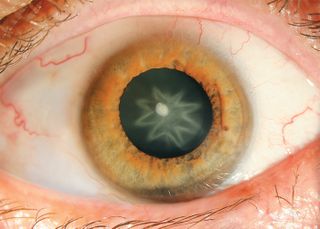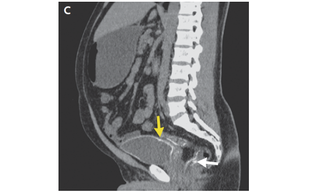27 oddest medical cases
Introduction

Have you ever been to the doctor because you had a fish jaw stuck in your eyeball? Or perhaps you've been rushed to the hospital after accidently inhaling your own earring? If you answered no to both of those questions, then consider yourself lucky: Fishy eyeballs and inhaled earrings are two real (and really bizarre) medical cases that have cropped up in recent years.
When doctors encounter such weird cases, they sometimes decide to publish a case report. Case reports are meant to add to scientific research, or help other doctors who might encounter the same strange symptoms in the future. But for those who aren't doctors, case reports illuminate the limits and the mysteries of the human body. Some also serve as highly effective cautionary tales.
Here's a look at 27 cases that will make your next trip to the doctor seem like a total bore.
Editor's Note: This article was first published on July 2, 2013, at 3:45 p.m. ET.
Enormous tapeworm

You know what they say about raw beef: You shouldn't eat it (at least, not unless you cook it first).
A man in China learned this lesson the hard way after finding out that he had a 20-foot-long (6 meters) tapeworm living inside of him— a result of chowing down on uncooked cow meat.
The tapeworm likely lived inside the man's small intestine for at least two years before he went to see the doctors who would ultimately help him flush out this lengthy stowaway. [Here's a list of top meats that can make you sick.]
The man complained of stomach pain, vomiting, loss of appetite and weight loss; his doctors were able to quickly identify the cause of these symptoms because the patient brought along a crucial piece of evidence — a fragment of the parasite, which he had found in his stool. Combined with the patient's known predilection for raw beef, the tapeworm specimen helped doctors guess that the man was sharing his intestine with Taenia saginata(a species of beef tapeworm).
After being treated with an antibiotic that caused him to pass the tapeworm out of his body within hours, the man's symptoms cleared up in just three months, according to a case report published in The New England Journal of Medicine in January 2016. Presumably, the man's preference for uncooked beef passed just as quickly.
Parasitic worm infection

What's worse than a parasitic worm infection? A parasitic worm infection that causes a "calcified bladder" — a condition that probably feels every bit as uncomfortable as it sounds.
A 43-year-old man in Qatar found out just how painful a calcified bladder can be. He had blood in his urine and pain when he peed for a month before doctors diagnosed him with an infection by the parasite Schistosoma, which is transmitted by freshwater snails.
The man's infection was located near his bladder and ureters(the tubes connecting the bladder to the kidneys). Eggs of the parasite ended up on the wall of the man's bladder, and his body's immune response caused these areas of the bladder wall to become calcified in a pattern known as "eggshell calcification," according to a case report published in The New England Journal of Medicine in February 2016.
While this kind of calcification as a result of schistosomiasis(another name for aSchistosoma infection) is not rare, it is unusual for doctors to see a patient with an entire bladder encased in calcium, since it takes years for that much calcium to build up inside the body.
But the patient's doctors suspected that the man actually became infected with the parasite as a child and that he lived with it for at least 30 years before doctors prescribed a treatment.
Fish bone in the eyeball

Nothing ruins a day at the beach quite like getting a fish bone stuck in your eyeball. Unfortunately, that's what happened to a beachgoer visiting the Red Sea in 2015.
The 52-year-old tourist was swimming in the Red Seawhen he collided with a school of fish. Not long after the incident, the man developed a swollen and droopy eyelid that wouldn't heal. A doctor's visit revealed he had an area of inflammation called a granuloma on his eyelid, and the patient underwent surgery to correct the issue.
But a granuloma wasn't the only thing that doctors removed from the erstwhile swimmer's eyeball during the surgery. "Two tubular structures" were also removed from the man's eyelid, according to a report published in the New England Journal of Medicine in September 2015.
A biologist was called in to examine these strange specimens, which turned out to be the jawbones of a halfbeak, a fish that dwells in shallow coastal waters. The fish bones had immobilized the muscles controlling the man's eyelid, causing it to droop. But the droopy-eyed swimmer recovered shortly after his surgery.
Sudoku seizures

You know that expression "too much of a good thing?" Well, that applies to this next case. A young man in Germany completed so many Sudoku puzzles (a logic game that may help sharpen memory) that he began having seizures.
Of course, that's only part of the story. The man had been an avid Sudoku solver for some time before experiencing such seizures, but that changed after he was trapped in an avalanche during a ski trip. He was eventually rescued, but while buried under the snow, the man experienced a condition known as hypoxia, in which the body tissues and brain don't receive enough oxygen. This condition caused the man to develop sudden muscle twitches around his mouth when he talked and in the muscles of his legs when he walked. He also experienced spontaneous seizures in his left arm. Doctors prescribed anti-epileptic medications and thought they had these seizures under control.
However, a few weeks after he was discharged from the hospital, the man began having seizures in his left arm again … but only when he did Sudoku puzzles.
Eventually, doctors got to the root of the problem: The man had a very intense "three-dimensional imagination" that was activated whenever he did these brain-stimulating puzzles. The part of his brain that he used when thinking about things in 3D happened to be the part of his brain that was most affected by his 15 minutes of oxygen deprivation under the snow. Overactivating this damaged part of his brain was what caused the man's seizures. Unfortunately, he had to give up Sudoku in order to make a full recovery.
Leaking brain fluid

Need a reason to skip Pilates class? Because we've got a good one: In 2015, a British woman with persistent headaches found that the reason for her pain was leaking brain fluid brought on by (you guessed it) a Pilates class.
It typically takes some kind of trauma for brain fluid — a clear liquid that flows between the brain and spinal cord and their outer coverings — to leak. Trauma from car accidents, tumors and botched surgeries are all known to sometimes cause this problem. But in certain people, brain fluid leaks can occur spontaneously when too much pressure is put on the skull or spinal cord, which is probably what happened to the Pilates-performing patient with persistent headaches.
After a standard treatment of bed rest, caffeine and ibuprofen, the woman recovered, according to a report published in the Journal of Medical Case Reports.
Toothy brain tumor

It's not entirely unusual for a 4-month-old baby to have a few teeth, unless those teeth are lodged in the baby's brain.
An infant in Maryland had teeth form in his brain as a result of a specific type of rare brain tumor. Doctors were able to remove the tumor and the boy made a full recovery, according to a report published in the New England Journal of Medicine in February 2014.
Doctors suspected something might be going on inside the boy's brain when his head appeared to grow faster than was usual for his age. A scan of the child's brain revealed a tumor that contained what looked like teeth normally found in the lower jaw. And indeed, when doctors removed the tumor they extracted several fully formed teeth with it.
While teeth do sometimes appear in tumors, the type of tumor removed from the infant's brain — a craniopharyngioma — wasn't known to host these strange additions.
Energy drink heart attack

What could cause a healthy 26-year-old to suffer a heart attack? Drinking nearly a dozen energy drinks a day, every day, that's what.
A man in Texas told doctors that he regularly consumed eight to 10 caffeine-laden energy drinks a day before suffering a heart attack. He also smoked a pack of cigarettes a day for two years prior to the incident, according to a report published in the journal Case Reports in Emergency Medicine in February 2015. [5 Health Problems Linked to Energy Drinks]
It's possible that the excessive amount of caffeine in these drinks, as well as other potentially harmful substances, may have reduced blood flow in the man's coronary blood vessel, causing a blood clot to form and ultimately resulting in a heart attack. The report's authors also noted that smoking may have led to the constriction of the man's coronary artery.
Inhaled earring

This is not what people mean when they say they want to "ring in the New Year" — A woman in Australia accidentally inhaled an earring at a New Year's Eve party in 2015.
The 41-year-old woman, who had asthma, reached into her purse for her inhaler when she began to wheeze during the New Year's festivities. Unbeknownst to her, a loose earring from her purse had become lodged in the inhaler, and she inhaled it when she used the device.
The earring scratched the back of the woman's throat, causing her to wheeze more and cough up blood, before it became lodged in her right bronchus (one of the main airways leading from the windpipe to the lungs), according to a report published in the journal BMJ Case Reports in April 2015.
Doctors were able to remove the earring, and the woman healed quickly. She also learned an important lesson about replacing the lid on her inhaler after every use.
Hepatitis from tea

Green tea is supposed to be good for you; researchers have found that compounds in the beverage may help suppress lung cancerand improve certain brain functions. However, drinking too much of the green stuff is not a good idea if you're not sure what else is in the teabag, according to report published in the journal BMJ Case Reports in October 2015.
A 16-year-old girl in the U.K. learned this lesson the hard way when, after consuming about three cups of green tea a day for three months, she started to show symptoms of acute hepatitis, or inflammation of the liver.
The girl had ordered the suspect tea online (after hearing claims it could help her lose weight). Most of the beverage's ingredients were in Chinese, so she wasn't sure exactly what was in the alleged "weight loss" beverage. Her doctors didn't analyze the exact chemical makeup of the tea, but once the girl stopped consuming it, her symptoms — which included jaundice, joint pain and dizziness — improved quickly.
Baking soda craving

Pregnancy cravings are normal, but indulging unusual cravings when pregnant can sometimes be dangerous. Case in point: A woman who consumed a 1-pound box of baking soda a day, both before and during her pregnancy, developed serious muscle and heart conditions, according to a report published in the journal Obstetrics and Gynecology in August 2013.
What caused the woman to crave an ingredient most commonly found (in very small quantities) in baked goods? The doctors who diagnosed her believe it was a condition known as pica, which is common during pregnancyand is characterized by cravings for nonfood items, such as baking powder, clay or dirt. [9 Uncommon Conditions That Pregnancy May Bring]
Baking soda is mostly made up of sodium bicarbonate which, when consumed in large quantities, can disturb the body's normal metabolic processes. In the case of the mother-to-be, downing such a large quantity of baking soda resulted in weakening of the heart and other muscles. Luckily, doctors were able to induce labor and the woman delivered a healthy baby.
Sign up for the Live Science daily newsletter now
Get the world’s most fascinating discoveries delivered straight to your inbox.

